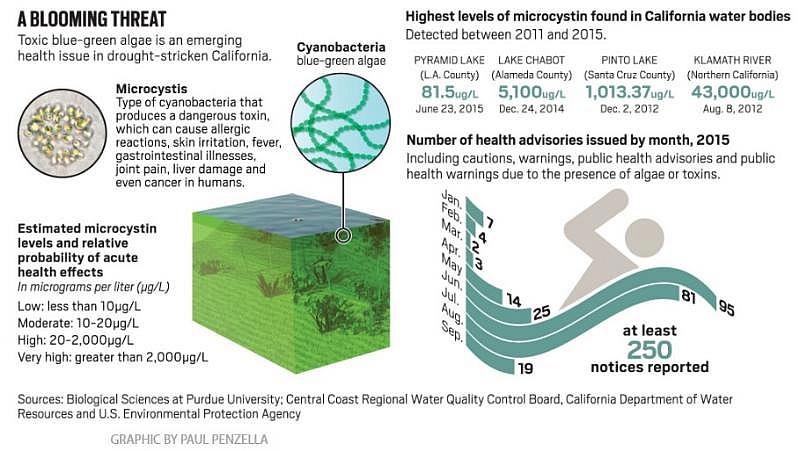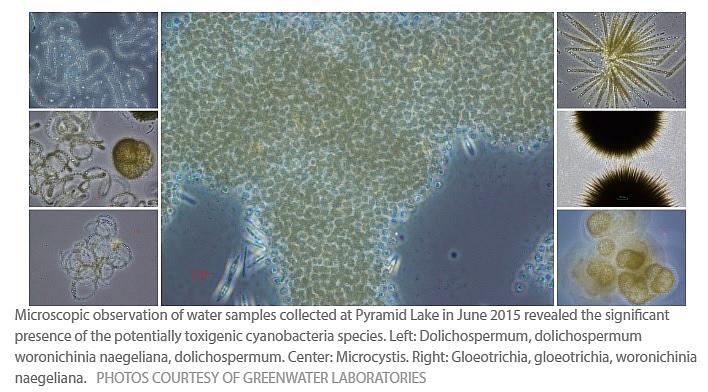Wading into danger: Growth of toxic algae could make California's lakes unsafe?
This article was produced as a project for the 2015 California Data Fellowship, a program of the Center for Health Journalism at the USC Annenberg School for Communication and Journalism.
Other stories in the series include:
What’s being done to assess blue-green algae’s risk to humans
Toxic algae is blooming more often in our lakes, reservoirs. Does that threaten our drinking water?
Don’t go swimming at Pyramid Lake due to toxic algae bloom, water officials say
People play in water tainted by blue-green algae at Silverwood Lake in San Bernardino County on Sunday, June 19, 2016.
It took less than 30 minutes for Posie to die.
One moment, the 2-year-old golden retriever was swimming alongside the Rudas’ canoe on the Russian River in Northern California. The next, she was seizing and foaming at the mouth.
“That’s when I saw her eyes roll back,” said Brooke Rudas, recalling the last time she and her husband saw their dog alive. “We had no idea that it could have been the water that had done this to her.”
What killed Posie that day last August was indeed something in the water: a dangerous toxin produced by a type of bacteria growing in lakes and rivers all over the world. Cyanobacteria, commonly known as blue-green algae, produce potent toxins that sicken people and animals.
An 'algae world'
The bacteria are some of the oldest microorganisms on the planet. While not all species produce dangerous toxins, experts say the numbers of toxin-producing bacteria are rising.
Drought and climate change intensify the problem — cyanobacteria grow thicker and faster when lake levels are low, temperatures are high and water is stagnant. At the same time, increasing agricultural runoff and sediment cycling provide more nutrients for the bacteria to feed on and grow into the large, paint-like blooms they’re known for.

“We now live in an algae world,” said Carolyn Jones, a spokeswoman for the East Bay Regional Park District, which began detecting cyanotoxins in 2014.
Last year, the park district closed five lakes after detecting high levels of microcystin, the most common cyanotoxin found in the United States.
While there were no reports of people getting sick from swimming in the lakes or from eating fish caught there, park officials believe at least three dogs died and others fell ill after being exposed to microcystin in the water.
Blooms typically appear in the U.S. during the summer months from late May through October. But they also appear at other times of the year at toxin levels high enough to send swimmers to the hospital.
Algae-infested waters with enough toxins to give people gastrointestinal symptoms, neurological problems and other adverse health effects have been detected all over California, studies show.
“No one expects the algae to go away anytime soon,” Jones said. “We expect it to get worse.”
Extent of public health effects 'unknown'
There are no confirmed human deaths from cyanotoxins in the U.S., but there are documented fatalities in other countries. In Brazil, 60 dialysis patients died in 1996 after being exposed to toxins in the water supply.
And while acute poisonings are well-documented, little is known about the health impacts from short-term exposure associated with recreational activities or chronic exposure associated with drinking water.
Cyanotoxins can cause allergic reactions, skin irritation, fever, diarrhea, vomiting, joint pain, liver damage and even cancer.
“There’s still a lot of unknowns,” said Virginia Roberts, an epidemiologist for the Centers for Disease Control and Prevention.
Roberts said health officials still need to figure out “what’s the difference between drinking the water, swimming in the water, walking on the beach or eating a contaminated fish.”
Dogs are more prone to toxin poisoning because they ingest more water while swimming and lick their fur clean.
“It’s very toxic to humans also,” said Karen Taberski, a senior environmental scientist for the State Water Resources Control Board, which is preparing a plan to better assess and manage cyanotoxinsacross the state. “You’re not getting mats on your skin. You’re getting a much more dilute exposure.”
When it's not safe to swim
The water board and a group of other state agencies, water managers and tribes — together known as the California Cyanobacteria Harmful Algal Bloom Network — are developing new standards for when to notify recreational water users about the potential risk of swimming, wading, boating or fishing in water where three different cyanotoxins have been detected.
Draft signage cautions people not to swim or wade, and to keep children away from the water if more than 0.8 micrograms per liter of microcystin are found in the water or if any anatoxin-a — the toxin that killed Posie — is detected. People should stay away from the water if 1 microgram per liter of cylindrospermopsin is detected, according to the suggested thresholds.
Water testing data from various agencies show that toxin levels across California exceeded the proposed thresholds in more than 100 lakes, reservoirs and streams in at least 36 counties, including Los Angeles, San Bernardino, Riverside and Orange, between 2011 and 2015.
Lack of Regulations
California does not track reports of human and animal illnesses linked to blue-green algae exposure and the federal government does not require states to monitor cyanotoxins in drinking water and recreational water, so it’s difficult to know how many people are getting sick. Still, the toxins have been on California officials’ radar for years and some state authorities, local health departments, water managers, researchers and tribes voluntarily test for the toxins.
But because these groups are not mandated to report toxin levels and rely a wide range of standards set by different states and agencies to decide how to respond to algae blooms, mitigating the health risks posed by toxins is more difficult.
“Most states have some kind of monitoring program — California has been behind quite a bit,” said Wayne Carmichael, a professor emeritus at Ohio’s Wright State University who has studied cyanotoxins for more than 40 years.
Confusing standards
In 2012, California’s Office of Environmental Health Hazard Assessment, which is responsible for evaluating health risks posed by environmental contaminants, issued recommended action levels for exposure to cyanotoxins in recreational water. These exposure thresholds are levels at which no health effects are expected but additional monitoring or posting of warning signs is recommended.
A sign warns people entering the East Bay Regional Park District about toxic algae at Lake Chabot in October 2015. PHOTO BY STEPHANIE K. BAER
But because these levels — 0.8 micrograms per liter of microcystin, a little less than a drop of water in an Olympic-sized pool — tend to be much lower than those adopted by other states and public health organizations, agencies have questioned their validity when deciding whether a warning is necessary.
The World Health Organization says 20 micrograms per liter of microcystin, the most common cyanotoxin, poses a “moderate risk” to human health. Two states, Vermont and Virginia, recommend humans and animals should have no contact with the water when 6 micrograms per liter of microcystin is present.
“You can see there is a mixed bag,” Jeff Janik, a former environmental scientist for the state Department of Water Resources, wrote in a June 24, 2015 email regarding an algal bloom at Los Angeles County’s Pyramid Lake, one of more than 30 drinking water storage facilities, reservoirs and lakes that make up the California State Water Project.
A concentration of 79.5 micrograms per liter of microcystin — 99 times more than the state advisory level — was detected in a water sample collected from the Southern California lake on June 8, according to data from the Department of Water Resources. Two weeks later, the level of microcystins remained high at 81.5 micrograms per liter, the data shows.
“Everyone would most likely initiate some kind of action at Pyramid’s levels,” Janik wrote in the June 24 email to department staff.
State slow to tell public about toxins
This was the first time the department, which began tracking the toxins in 2006, ever detected toxin levels that raised a concern about the health and safety of people who swim, water ski, boat or fish at Pyramid, but it took several weeks for officials to notify the public about the potential health risk posed by the water.

Had the same levels been detected in a lake in Vermont, the area would have been closed to swimmers.
Tanya Veldhuizen, manager for the department’s aquatic nuisance species program, said in an email that it took a week for the department to receive the results of June 8 toxin testing from GreenWater Lab, a Florida facility that conducts toxin analysis for agencies and organizations all over the U.S., and because officials had never seen such a high level of microcystin at Pyramid or anywhere else in the State Water Project they “needed to first confirm the accuracy of the results.”
“Confirmation of results took a few days,” Veldhuizen wrote.
Emails obtained through a California Public Records Act request show state officials contemplated closing the swim beaches at Pyramid on June 19. One week later, after receiving additional results that showed the toxin levels were unchanged, the department posted signs advising lake visitors about potential health issues posed by the algal bloom.
'Don't let the dogs in the water'
According to WHO standards developed in 2003, the level of microcystins identified at Pyramid Lake on June 8 posed a “high” probability that recreational users would experience adverse health effects if exposed to the toxins. People who came into contact with lower levels of the same toxin in Ohio lakes experienced skin rashes, diarrhea and vomiting during four separate outbreaks between 2009 and 2010, but no one reported falling ill at Pyramid last summer.
State officials wrangled for weeks over how to get rid of the toxic bloom and were prepared to treat the reservoir with a copper-based algaecide to get rid of the bacteria, but the toxin levels eventually subsided and the advisory signs were taken down.
“We were just told that it was a warning,” a lifeguard working at the beach at Emigrant Landing told a reporter on a recent afternoon. “They assured me that everything was fine.”
But, the lifeguard, who spoke on the condition of anonymity because he was not authorized to speak, said he did not know that there were toxins in the water when the state posted the signs.
All he was told, he said, was “Don’t let the dogs in the water.”
[This story was originally published by SGVT.]
Photos by Watchara Phomicinda/SGVT

